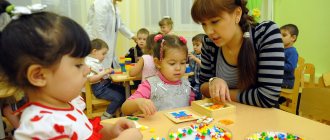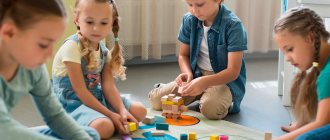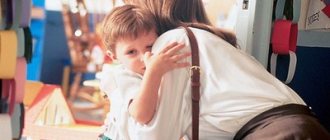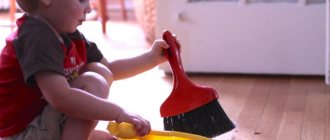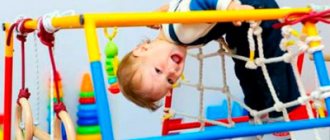Tweet
Christmas is the most important and joyful Christian holiday. After all, it glorifies the birth of Man and God in one person, Jesus Christ. It is celebrated on January 6th. The night before Christmas is considered magical. And if you make a kind, sweet, wise wish on this night, it will definitely come true.
After all, it was love, kindness and wisdom that Jesus Christ taught people.
This holiday is celebrated by the whole family, so children should know its history, traditions, and customs.
Today we will tell the story of the Nativity of Christ for children.
The story of the birth of Jesus, the story of Christmas for children
Jesus' parents were Mary and Joseph. Although in fact the father of Jesus is the Lord God, Joseph was entrusted with the mission of raising the son of God.
The Virgin Mary and her husband, Joseph, lived in the town of Nazareth. Because of the Roman Empire's census, they were forced to go to Bethlehem. There were many people in Bethlehem who had arrived for the census, all the houses and hotels were occupied, so Mary and Joseph had to spend the night in a cave, which the shepherds used to shelter their livestock from the weather. It was in it that Jesus was born - the One who was destined to become the Savior of the world.
Since there was no crib in the cave, the parents put the baby directly in a manger, a special box from which animals eat. It was just filled with hay.
Shepherds with their flock passed near the cave. They saw a bright light and an angel. An angel announced to them about the birth of Christ, who came to earth to save the world from sins. The angel told the shepherds how to find the Baby.
The shepherds left their flocks and went towards Bethlehem, where they found the Virgin Mary, Joseph and the Baby in a manger in a cave.
And at this time, somewhere in the east, three wise men, who were called the Magi, saw the bright star of Bethlehem in the sky, which showed them the way to the newborn baby. They knew that the Savior, who was destined to become the King of Heaven on earth, would soon come to the world, and they went to him with gifts (gold, incense, myrrh).
The reigning king at that time, Herod, having heard the news of the birth of a new king, was afraid that he might replace him on the throne, so he ordered to kill all the babies in the city. But Jesus was no longer in the city at that moment. An angel appeared to Joseph and said: “Get up, take the Child and His Mother and flee to Egypt, and remain there until I tell you, for Herod wants to look for the Child in order to destroy Him.” Thus, the Son of God miraculously managed to survive.
Miracle of Christmas
The miracle of Christmas is that for the first and only time, the immaculate Virgin gave birth to a Child. The news of the birth of Jesus, the Son of God, was brought by an Angel. From that moment on, Mary and her betrothed Joseph eagerly awaited God's child.
Therefore, it is believed that at Christmas the heavens open and you can ask them for anything. The main thing is that the desire is kind, sincere and bright. On the night before and on Christmas, miracles happen: people are healed of illnesses, their dreams come true. You only need to believe in a miracle with all your heart.
A story about Christmas for children needs to be supplemented with holiday symbols.
Symbols of the Nativity of Christ
Nativity scene
The direct meaning of the word is cave. The Nativity scene is the cave in which Jesus Christ was born.
The figurative meaning of the word Nativity scene is a reproduction of the Nativity scene using art. This could be a stage performance depicting the birth of the Child Jesus Christ.
Bethlehem Christmas star
The Bethlehem Christmas Star is an eight-pointed Star that appeared in the sky at the moment of the birth of Jesus Christ and showed the way to the wise men to the cave. The Star of Bethlehem symbolizes the good news of the birth of Christ.
Magi
Magi are sages whose power lay in the knowledge of secrets inaccessible to ordinary people.
Gifts of the Magi
The Gifts of the Magi are the three gifts they gave to Jesus: gold, frankincense and myrrh. Each of them has its own symbolic power:
* Gold is a gift that shows that Jesus was born to be King.
* Frankincense is a gift to the priest, because Jesus was to become the new Teacher and High Priest.
* Myrrh is a gift to someone who is about to die, it was used to embalm the body of the deceased.
Christ's manger
The manger of Christ is a feeding trough for domestic animals, in which Mary placed the newborn baby, as if in a cradle.
Christmas Eve
Christmas Eve - January 6th. On Christmas Eve, Orthodox Christians prepare for the upcoming holiday.
Kutya, sochivo
Sweet kutia, made from wheat, rice or other grains, is a real treat for children. On Christmas Eve they prepare Lenten kutya or, as it is also called, sochivo. Sochivo is a lean dish made from rice or wheat with the addition of honey, raisins, candied fruits and candied fruits.
Methodological recommendations “How to create a children's research project”
Guidelines
How to create a nursery
research project?
Prepared by a primary school teacher
MBOU Secondary School No. 4 MO "Baryshsky District"
Novikova Anzhelika Olegovna
Among the various areas of new pedagogical technologies, the leading place is occupied by design and research activities. In accordance with the requirements of the second generation standards and improving the quality of students' knowledge, it is necessary to develop students' cognitive and creative abilities. The leading place is occupied by such forms of independent work of students, which are based not only on the application of acquired knowledge and skills, but also on obtaining new ones on their basis.
Project from a student's perspective –
this is an opportunity to do something interesting on your own, in a group or by yourself, making the most of your capabilities; This is an activity that allows you to express yourself, try your hand, apply your knowledge, bring benefit and publicly show the results achieved.
From the teacher’s point of view, an educational project is a didactic tool that allows you to teach design, i.e. purposeful activity to find a way to solve a problem by solving problems arising from this problem when considering it in a certain situation.
Working as a primary school teacher, I am concerned about the low level of development of students' research skills, the lack of cognitive interest in children in finding answers to questions and problems that arise during the learning process. Having studied the literature on this issue, I came to the conclusion that the most interesting and productive way to stimulate and develop these skills is through design and research activities.
Creating a children's project consists of the following stages:
— preparatory;
- indicative;
— organizational;
- productive.
During the preparatory
At this stage, it is necessary to select a research topic and specify it. I always try to offer the student interesting topics, I strive to interest the child, “infect” him with ideas, and draw work prospects in his mind.
The topics of projects of students of this age should be closely related to the subject content, since visual-figurative thinking characteristic of this age, curiosity, interest in the world around them push students to choose a topic based on the specific content of the subject, and not on the basis of an analysis of their experience and their problems. Therefore, a significant part of the educational time allocated for repetition and consolidation of the studied material can be used to organize project activities.
Approximate
stage is the determination of the goals and objectives of the project, the selection of a subject or design object. The student must clearly understand what he is designing, why and why he is doing it.
The third stage is the most labor-intensive
, it involves organizing work on the project and drawing up a work plan. At this stage, you can apply various design methods, which in turn form and develop search skills. This can be: independent reading, studying books, observation, interviews, experiments, access to the global computer network Internet.
While searching for information, a student needs to at least briefly study the history of the issue, different points of view on this phenomenon, as a result of which interesting facts are discovered.
The last stage - productive - is the design of the work
, preparation for defense, questions. The guys present their creative projects (finished product), demonstrating an understanding of the problem, the purpose and objectives of this work, its relevance, novelty, practical and theoretical significance, evidence or refutation of the hypothesis, the ability to plan and carry out their activities, as well as the found method of solving the problem. In this case, the role or share of participation in the project of each student is taken into account. The student must clearly know the entire path of working on the project from choosing a topic to the result of the project in order to successfully present his work.
The results of completed projects must be “tangible”. If this is a theoretical problem, then a specific solution; if it is practical, then a specific result, ready for use in class, at school, in extracurricular activities, at home. It is necessary that this result can be seen, comprehended, and applied in practical activities.
The role of the teacher is great in the first and last stages. And the fate of the project as a whole depends on how the teacher fulfills his role at the first stage - the stage of immersion in the project. At the last stage, the role of the teacher is great, since primary school students are not yet able to generalize everything that they have learned or researched, to come to conclusions that the teacher with his rich worldly experience, scientific outlook, and analytical thinking will help to make.
As a result of working on a project, children learn to think broadly, act consistently, and achieve their goals. The student already more or less clearly understands the entire structure of the search; he is motivated to study new unknown topics and facts. An invaluable consequence of the development of such a skill is that a junior student enters a new stage of development and can successfully realize himself in studies at the middle and senior levels. After all, the main thing is that the child develops independent work skills when searching for and processing information.
The project method in elementary school makes it possible to most widely cover all types of student activities, as it includes cognitive, playful and creative activities, involving all aspects of children’s lives at school and at home. This is the path of cognition, a way of organizing the process of cognition. It promotes the implementation of the principle of connection between teaching and upbringing and life, and solves many pedagogical problems.
I try to prepare my children for life so that all the knowledge they receive is useful to my students. And I consider the project method a universal means of human development.
Children about Christmas, Christmas traditions
Fasting before Christmas
It is customary to fast 40 days before Christmas. It is needed to cleanse the body and soul. During the period of fasting, you cannot eat certain foods, including meat, as well as quarrel, get angry, and be offended. Fasting is needed precisely so that everyone becomes a little kinder.
Christmas Eve
The last day of Lent and the evening before Christmas is usually called Christmas Eve. Its name comes from the name of the dish - sochivo, which is prepared from cereals - rice, barley, wheat. Cereals are boiled and soaked with poppy seeds, nuts, fruits, raisins, candied fruits, and honey.
There should be 12 Lenten dishes on the table on Christmas Eve, as many as Jesus had apostles.
The Story of Christmas Eve
Once upon a time, people began to celebrate Christmas on January 6th. Mom prepared 12 Lenten dishes, and the children waited for the first star to appear in the sky. As soon as she appeared, Christmas Eve began. Then the father brought hay into the house and laid it on the table. After all, it was on the hay that little Jesus was laid. A small nest was made from hay, in which a pot of kutia (sochivo) was placed.
Before dinner, they lit a candle and prayed together. Only after prayer could dinner begin.
Kutya (sochivo) is the most important dish on the table. In addition to kutya, they served fish, cabbage rolls, pies with cabbage, pancakes... The food was washed down with uzvar. For dessert they baked pies with poppy seed filling.
After Christmas Eve, the children went to their godparents, brought dinner (bread and salt, kutya, rolls), and they treated the kids, gave them candy and money.
On Christmas night it was customary to carol. Children, youth and everyone else went to the houses of neighbors and relatives, sang carols, wishing them good health and prosperity. In return, the owners gave the carolers sweets and coins. It was believed that the more carolers who come to the house, the more joy there will be this year.
And on Christmas Eve they showed a nativity scene - a performance about the birth of Jesus.
Christmas tree decoration
The Bethlehem guiding star has long been considered a traditional Christmas tree decoration, which is attached to the top of the tree. In ancient times, the Christmas tree was decorated with paper figures and flowers, apples, and sugar. The tradition of decorating a Christmas tree is associated with the tree of paradise, hung with apples.
Christmas presents
In memory of the gifts that the wise men brought to Jesus, they give each other gifts at Christmas. Read about what you can give for Christmas here:
What to Give Grandma for Christmas, 135 Gifts for Grandma for Christmas
What to give for Christmas
What to give for Christmas - a girl, a guy, a child, a man, a woman?
Christmas gifts for parents: interesting options
Christmastide
Christmastide begins with Christmas - holidays that last until Epiphany Eve and are accompanied by mass festivities, visits to relatives and friends.
Research work of a preschooler. Example
Research work.
Topic: “The Magic of Soap Bubbles” CONTENTS: 1. Introduction……………………………………………………………………………….2 2. Main part: 2.1 Theoretical part…… ………………………………………..……4 2.2. Practical research……………………………………………………….……6 3. Conclusion…………………………………………………………………………………. 9 4. References…………………………..…………………………10 * * * 1. Introduction. It burns like a peacock's tail, What colors are there not in it! Purple, red, blue, green, yellow! A light ball is playing with lights in the open space. Now the sea turns blue in it, Now there is a fire burning in it... There were so many colors in it, There was such arrogance, And he was water and soap, a bloated mixture. S.Ya. Marshak. Relevance of the topic: In the summer, my mother bought me soap bubbles. My brother and sister and I had fun blowing bubbles. We did this while running, and from a height, and blew in different directions and with different strengths. It was fun, but not for long. The solution quickly ran out. We made a new solution. But we didn’t get the kind of bubbles we had. I became very interested in what needs to be added to the solution to make the bubbles bright, large and strong. I asked my mother to help me study the history of soap bubbles and the secret of the solution. Research topic : “The magic of soap bubbles.” Purpose of the study: To study theoretical material on the topic “Soap Bubbles”. Conduct research on soap bubble recipes and identify the most effective ones. Objectives: 1. Analyze the scientific literature on the topic being studied. 2. Conduct a study of the effectiveness of liquids for blowing soap bubbles. 3. Investigate the properties of soap bubbles obtained from different solutions, as well as using different detergents. 4. Draw conclusions. Object of study : solutions for soap bubbles. Subject of research : obtaining large bubbles from different solutions. Research methods: 1. Analysis of scientific literature on this study.
2. Observation of soap bubbles from various solutions. 3. Experiment. Hypothesis: 1. Suppose that soap bubbles are formed from a soap solution. 2. The size and stability of soap bubbles depends on the composition of the bubble liquid. 2. Main part.
2.1.Theoretical part In order to find out how and when soap bubbles appeared, first of all, my mother and I went to the library. Together with the librarian, we tried to find at least some information about soap bubbles. We looked through the children's encyclopedia "Everything about everything", "I want to know everything", and studied other children's encyclopedias. And no information. True, along the way I learned what soap is made from, what detergents are needed for, when the first powder was invented. Time, of course, was not wasted. But I haven’t found anything about soap bubbles yet. Then I asked my older brother to find information on the Internet. and we found... A soap bubble is a thin film of soapy water that forms a sphere with an iridescent surface. When and where exactly soap bubbles appeared remains a mystery to this day. But it is known for certain that during excavations of ancient Pompeii, archaeologists discovered unusual frescoes depicting young Pompeians blowing soap bubbles. This means that bubbles delighted children and adults back in the days of ancient Pompeii. Apparently they had their own secrets for making soap. There is a legend about the appearance of the first soap bubble: one fine day, when soap was finally created, the king, not joking at all, ordered everyone to wash themselves with soap under pain of death. And everyone washed their washcloths that day. Only one old shoemaker named Pumpatus sat hidden in his shoebox. More than anything else, Pumpatus hated washing his neck. Footsteps were heard outside the window. Two huge guards took Pumpatus by the armpits and five minutes later they were leading him to the city prison. In the room where Pumpatus was locked, there was a bathtub with soapy foam and a lot of towels. "Agree?" - asked two huge guards. "Never!" - answered Pumpatus. And he was left to smoke his pipe for the last time. Pumpatus took a drag and suddenly saw a beautiful transparent ball fly out of the tube. The ball flew out the window and shone in the Sun: small rainbows were jumping in it. After the first ball, the second one flew out... Pumpatus looked with all his eyes at the miracle taking place. The passers-by below also raised their heads to look at it. Soon a crowd gathered and a commotion began. Everyone, of course, forgot to think about the fact that Pumpatus was supposed to be executed. The professor, who was invited to figure it out, examined Pumpatus' pipe. “Soap scum got into the pipe. That’s what it’s all about,” the professor announced to the crowd outside the window. Pumpatus, of course, was not executed, and after that soap bubbles became popular not only in one small kingdom, but throughout the whole world! Even in the paintings of Flemish artists of the 18th century, there were often images of children blowing soap bubbles through a clay straw. In the 18th and 19th centuries, children blew soap bubbles using soapy water left over from washing. There is even a myth about the fragility of a soap bubble, but it was dispelled by the Englishman James Dewar, who preserved the soap bubble in a sealed vessel with double walls. An Indiana physics teacher managed to preserve a bubble in a glass jar for 340 days. The students surpassed the teacher - their bubbles were kept under lock and key for many years. A soap bubble is a thin multilayer film of soapy water filled with air, usually in the form of a ball with an iridescent surface. The bubble film is three-layer: it consists of a thin layer of water sandwiched between two layers of soap (soap + water + soap). This fun has long attracted children and adults. Soap bubbles usually last only a few seconds and burst when touched or spontaneously. 2.2 Practical research. After studying the theory and collecting information, I told the children in the group about it. The guys were very interested, they were so interested, they constantly asked me about everything. And then teacher Ekaterina Alexandrovna suggested that we conduct an experiment in kindergarten. And we all started the practical part of my research together. There are many recipes for making soap bubbles. Some of the composition of the bubbles is kept in the strictest confidence, because they allow one to blow truly gigantic soap bubbles, which are even included in the Guinness Book of Records. Others can be found in books or on the Internet. For my work, I chose several recipes. Recipe No. 1. This is the easiest way to make soap bubbles at home. Take 100 ml. dishwashing detergent and add 50 ml of glycerin and 300 ml of water, mix everything thoroughly and you're done! Glycerin is precisely the substance that makes the walls of a soap bubble stronger, and the bubble itself, accordingly, long-lived. Recipe No. 2. It's also not complicated at all. Add 50 ml of clear baby shower soap to a container with 60 ml of water. Add half a teaspoon of sugar. Mix everything and use it. Recipe No. 3. This recipe is much more difficult to make, but it produces bubbles that don’t burst. Water - 600 ml. (hot) add glycerin - 300 ml, drip - 20 drops of ammonia, and pour washing powder - 50 g. The entire composition is thoroughly mixed, infused for about three days, filtered and placed in the refrigerator for about twelve hours. Recipe No. 4. Take soap shavings - 4 tbsp. spoons add 400 ml of hot water. Leave for one week, and then add sugar + gelatin - 2 teaspoons. The solution is ready and you can try it. Recipe No. 5 You need to take 40 ml of baby shampoo without tears, add 60 ml of water, 2 teaspoons of sugar and 1 drop of food coloring.
Progress of the study:
Stage 1 Preparatory. For this experiment we needed the following substances: - distilled water - dishwashing liquid - glycerin - baby transparent shower soap - sugar - ammonia - washing powder - soap - baby shampoo - food coloring - gelatin. - kettle (boiling water). As well as cups, measuring containers, blowing tubes, scales. Stage 2 Preparing soap bubbles.
The compositions of all soap solutions were observed.
While blowing soap bubbles from different solutions, we made observations, took measurements and entered the data into a table. Soap bubble composition testing table. Composition No. Test ….. 1 ….. 2 ….. 3 ….. 4 ….. 5 Soap bubble lifetime ….. 5 sec ….. 10 sec ….. 2 sec ….. 4 sec ….. 8 sec Average size ..... 3 cm ..... 7 cm ..... 3 cm ..... 5 cm ..... 8 cm Maximum size ..... 8 cm ..... 10 cm ..... 5 cm ..... 5 cm ..... 10 cm Out of ten it turned out ..... 7/10 ..... 10/10 ..... 6/10 ..... 3/10 ..... 8/10 Of these small ones ..... 4 ..... 3 ….. 5 ….. 3 ….. 5 Of these large ones ….. 3 ….. 7 ….. 1 ….. — ….. 3 According to experiments, the victory is awarded to soap solution No. 2, and also practically divides with it the first place was solution No. 1 and 5. All other compositions did not show the best results. 3. Conclusion. The hypothesis of the formation of soap bubbles from a soap solution turned out to be correct: soap bubbles actually contain soap and detergents. But in addition to these main substances, you also need to add several components, the main ones of which are water, glycerin, a little sugar, food coloring, gelatin. The water for the solution should be soft or distilled. We have seen from our own experience that the best that can be is laundry and baby soap. For long-lived bubbles, it is recommended to add pure glycerin to the resulting solution. In general, any cleaning liquid will work for bubbles, but the best results will be obtained using the ingredients described. Making a soap solution for blowing soap bubbles at home is a completely doable and interesting activity. Blowing soap bubbles lifts your mood, forgets all your problems, and actually develops your lungs well. All this has a beneficial effect on health. References: 1. How to make soap bubbles 2. Malofeeva N. N. Big book of the most interesting facts. – M.: JSC “ROSMEN-press”, 2010. – P.149 3. Soap bubbles (video).
We recommend watching:
Project in the senior group of a kindergarten Project in the senior group on the topic “Trees and shrubs in spring” Practice-oriented project for landscaping the territory of a kindergarten Educational project. Second junior group
Similar articles:
Educational and creative project on the theme “Golden Autumn”. Junior group
Project for children of the senior group “Our cheerful garden”
